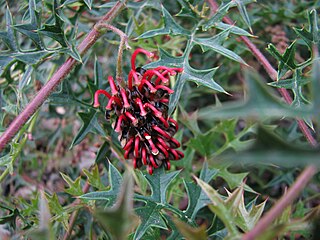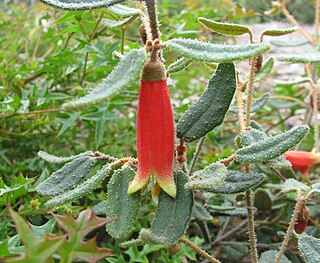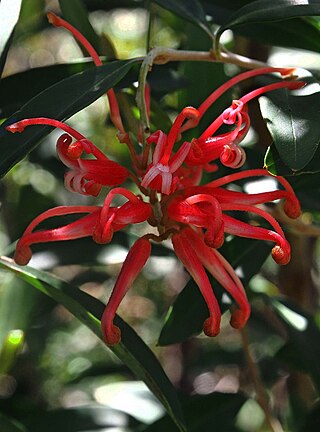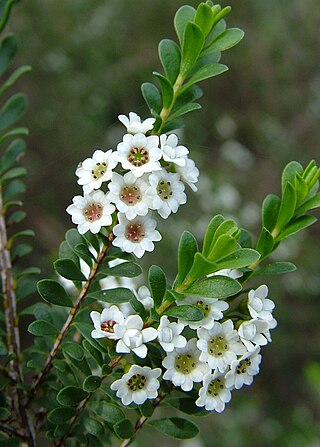
Stylidium is a genus of dicotyledonous plants that belong to the family Stylidiaceae. The genus name Stylidium is derived from the Greek στύλος or stylos, which refers to the distinctive reproductive structure that its flowers possess. Pollination is achieved through the use of the sensitive "trigger", which comprises the male and female reproductive organs fused into a floral column that snaps forward quickly in response to touch, harmlessly covering the insect in pollen. Most of the approximately 300 species are only found in Australia, making it the fifth largest genus in that country. Triggerplants are considered to be protocarnivorous or carnivorous because the glandular trichomes that cover the scape and flower can trap, kill, and digest small insects with protease enzymes produced by the plant. Recent research has raised questions as to the status of protocarnivory within Stylidium.

Grevillea microstegia, commonly known as Mount Cassell grevillea, is a species of flowering plant in the family Proteaceae and is endemic to Victoria in Australia. It is a prostrate to low-lying or straggling shrub with deeply divided leaves, the end lobes triangular, and toothbrush-shaped clusters of reddish-brown flowers with a red style.

Thryptomene micrantha, commonly known as ribbed thryptomene, is a species of flowering plant in the family Myrtaceae and is endemic to south-eastern Australia. It is a spreading to erect shrub with egg-shaped leaves, the narrower end towards the base, and white flowers with five petals and five stamens.

Grevillea infecunda, commonly known as Anglesea grevillea, is a species of flowering plant in the family Proteaceae and is endemic to a restricted area of southern Victoria in Australia. It is a low-lying to weakly erect shrub with divided leaves with three to sixteen lobes or teeth and greenish-yellow flowers with a dull pink style.

Grevillea montis-cole, commonly known as Mount Cole grevillea, is a species of flowering plant in the family Proteaceae and is endemic to central-western Victoria, Australia. It is a shrub with divided leaves with 5 to 15 lobes, the end lobes more or less triangular to narrowly oblong and sharply-pointed, and clusters of greenish to fawn and dull purplish flowers.

Grevillea bedggoodiana, commonly known as Enfield grevillea, is a species of flowering plant in the family Proteaceae and is endemic to a restricted area near Ballarat in Victoria, Australia. It is a prostrate to low-lying shrub with coarsely serrated, egg-shaped to oblong leaves and green and pink flowers.

Grevillea gariwerdensis is a species of flowering plant in the family Proteaceae and is endemic to Grampians National Park in Victoria, Australia. It is a shrub with more or less linear to narrowly oblong leaves, and white to pink flowers with brownish hairs.

Grevillea alpivaga, also known as buffalo grevillea, is a species of flowering plant in the family Proteaceae and is endemic to a restricted area of Victoria, Australia. It is a shrub with crowded, linear leaves and pale green creamy-white flowers.

Grevillea dimorpha, commonly known as flame grevillea or olive grevillea, is a species of flowering plant in the family Proteaceae and is endemic to the Grampians National Park in Victoria, Australia. It is an erect to spreading shrub with elliptic to linear or egg-shaped leaves with the narrower end towards the base, and groups of bright red flowers.

Grevillea jephcottii, commonly known as Pine Mountain grevillea, green grevillea or Jephcotts grevillea is a species of flowering plant in the family Proteaceae and is endemic to a restricted area of Victoria. It is a low dense, to tall spindly shrub with narrowly oblong to narrowly elliptic leaves, and clusters of pale lemon or greenish flowers with a purplish style.

Grevillea pachylostyla, commonly known as Buchan River grevillea, is a species of flowering plant in the family Proteaceae and is endemic to Victoria in Australia. It is a mounded to almost prostrate shrub with divided leaves, the end lobes triangular, and usually down-curved, more or less toothbrush-like clusters of cream-coloured flowers that turn` pink to red after opening.

Grevillea confertifolia, commonly known as Grampians grevillea or dense-leaf grevillea, is a species of flowering plant in the family Proteaceae and is endemic to the Grampians in Victoria, Australia. It is a spreading, often dense shrub with linear to narrowly oblong leaves, and reddish-purple flowers.

Correa reflexa var. angustifolia, commonly known as Grampians correa, is a variety of Correa reflexa endemic to Victoria in Australia. It grows to 1 metre tall. Leaves are up to 30 millimetres (1.2 in) long and 10 millimetres (0.39 in) wide and are dark green on the upper surface, while the lower surface is covered with hairs and pale grey. The pendent, tubular flowers are red with yellow-green tips.

Correa lawrenceana var. grampiana, commonly known as Grampians mountain-correa, is a variety of Correa lawrenceana that is endemic to Victoria, Australia. It is a shrub with elliptical leaves and cylindrical, velvety flowers covered with matted, woolly cream-coloured to yellowish brown hairs.

Grevillea monslacana, commonly known as Lake Mountain grevillea, is a species of flowering plant in the family Proteaceae and is endemic to mountainous areas of eastern Victoria in Australia. It is a spreading to erect shrub with narrowly egg-shaped leaves and clusters of pink to reddish pink flowers.

Thryptomene calycina, commonly known as Grampians thryptomene, is a species of flowering plant in the family Myrtaceae and is endemic to Victoria in Australia. It is an erect or spreading shrub with oblong, elliptic or egg-shaped leaves with the narrower end toward the base, and white flowers with five stamens.

Persoonia arborea, commonly known as tree geebung, is a species of large shrub or small tree that is endemic to Victoria, Australia.

Pimelea hewardiana, commonly known as forked rice-flower, is a species of flowering plant in the family Thymelaeaceae and is endemic to south-eastern continental Australia. It is a shrub with narrowly elliptic leaves and head-like clusters of 7 to 34 unisexual yellow flowers.
Mount Taylor Conservation Park is a protected area in the Australian state of South Australia located on Kangaroo Island in the gazetted locality of Newland. It was dedicated in 1970 primarily for the conservation of the rare triggerplant Stylidium tepperianum.
Lepidium monoplocoides, the winged peppercress, is a nationally endangered plant species endemic to inland south-eastern Australia. The winged peppercress can grow from 15 up to 20 centimetres tall. This plant has long, slender leaves. Because of destruction of habitat, this plant is endangered. The winged peppercress has green-brown flowers which grow at the end of stems.


















